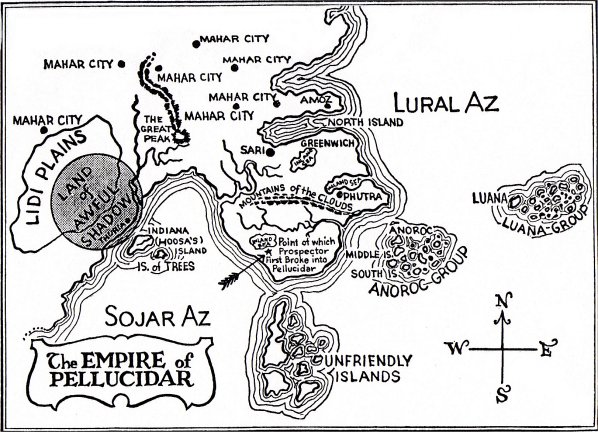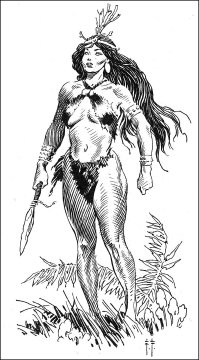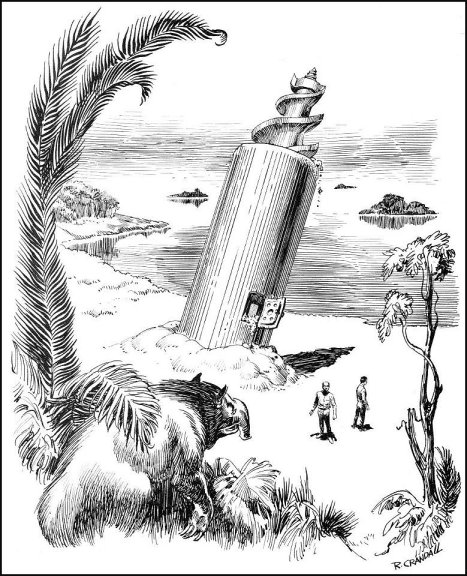
Possibilities in Pellucidar
By John Martin


Edgar Rice Burroughs loved telling a good story.
But he also loved hinting at a good story, and
leaving the tantalizing details to the inadequate imagination of the frustrated
reader.
The untold tale probably most famous to ERB fans
concerns the mysterious map found by "Tarzan the Untamed" on the body of
the dead explorer. What did Tarzan ever do with that map? ERB says no more
about it.
In the Pellucidar series, there are untold tales
as well -- hints of other things that did happen, that could happen, that
might have happened.
Here are some of those
untold tales:
The Long Trek Home
"Tanar of Pellucidar" is an action-packed adventure,
but when it finally ends, Tanar and his mate, Stellara, are still a world
away from their homeland. The last chapter reports: "The story of their
long and arduous journey through unknown lands to the kingdom of Sari would
be replete with interest, excitement and adventure, but it is no part of
this story."
And so we must forever wonder: What happened? Did
they endure capture, enjoy escape, and experience yet other recaptures
at the hands of weird races of people, as Von Horst and La-Ja did in "Back
to the Stone Age?" How close did they come to death? How many times were
they separated? What strange sights did they see? How many sleeps did the
journey take? Did they have any children by the time they reached Sari?
We'll never know!
The Quest for Harbenite
In the next book of the series, "Tarzan at the
Earth's Core," a lightweight airship must be built to carry the would-be
rescuers of David Innes to the inner world, and to build that aircraft
a special metal, called Harbenite, must be acquired. ERB writes:
"It is not my intention to weary you with a recital
of the details of the organization and equipment of the Pellucidarian expedition,
although that portion of it which relates to the search for and discovery
of the native mine containing the remarkable metal now known as Harbenite,
filled as it was with adventure and excitement, is well worth a volume
by itself."
But we don't have that volume on our bookshelves,
do we? What dangers confront that expedition? Was it Arab slavers? Fierce
cannibals? Tantor in must? Communist plotters? Lost civilizations? Amnesia
for Tarzan?
ERB chose to keep us guessing.
The March of the Waziri
In Chapter 3 of "Tarzan at the Earth's Core," Jason
Gridley is separated from the 10 Waziri warriors and Lt. Wilhelm Von Horst.
What became of Von Horst is told in another book, "Back to the Stone Age."
Of the Waziri's adventures in Pellucidar, however, we do not know much.
A brief update on the lost party is given in TEC-8
and the Waziri finally play a key role in Chapter 15, when they are reunited
with Tarzan. But are we to believe that they just had a peaceful stroll
through savage Pellucidar until the time when their scent just happened
to be wafted to the nostrils of the ape-man?
Nay, for there is no such things as a peaceful
walk through the Inner World. We are given only a hint of their adventures
when Tarzan asks them if they still have plenty of ammo for their rifles,
and they reply, "We have saved it, Bwana, using our spears and our arrows
whenever we could." That indicates there were times when the Waziri had
to resort to their rifles, because they faced an enemy that could not be
easily discouraged with the lighter weapons. So, they had adventures in
Pellucidar. We just don't know what those adventures were.
A story about the Waziri could also clear up some
mysteries for us. In TEC-3, the Waziri drop their rifles in panic while
fleeing the charge of the great carnivorous cats. In TEC-8, we read "they
had never again been able to locate the clearing" where the rifles lay.
Yet, when Tarzan encounters the Waziri, they have their rifles with them!
Obviously, between Chapters 8 and 15, the Waziri must have gotten turned
around again (something that is easy to do in Pellucidar) and by chance
ended up back at the clearing where their rifles lay. Then, after cleaning
the rifles, they somehow wandered around until coming back to the Gyor
Cors and the rendezvous with Tarzan. It sounds improbable, perhaps, and
yet, are not ALL of the adventures in Pellucidar improbable? That is what
makes them such great stories!
Another thing a Waziri story could do is shed just
a little more light on what happened to Von Horst. The German is with the
blacks in TEC-8; yet, as "Back to the Stone Age" begins, it appears that
Von Horst spends only a short amount of time with the Waziri, before becoming
separated from them. That's the key word: time. What seems like a short
time to us could, in Pellucidar, be enough time for Von Horst to go clear
to TEC-8 before splitting.
[However, a more likely reason for the Von Horst
discrepancy could simply have been ERB using literary license. "Back to
the Stone Age" was to be about Von Horst -- not Von Horst and the Waziri.
So, in writing BSA, ERB probably just simply and deliberately glossed over
the time Von Horst and the Africans had spent together.]
The 'Ana' Sisters?
 In "Tarzan at the Earth's Core," chapter 7, we learn that Jana, The Red
Flower of Zoram, had a sister, Lana, who had been stolen as a mate from
the Mountains of the Thipdars by men of the lowlands. We never learn any
more about poor Lana.
In "Tarzan at the Earth's Core," chapter 7, we learn that Jana, The Red
Flower of Zoram, had a sister, Lana, who had been stolen as a mate from
the Mountains of the Thipdars by men of the lowlands. We never learn any
more about poor Lana.
In "Land of Terror," we meet Zor of Zoram, who
"had been very much in love with a girl of Zoram, who one day wandered
too far from the village and was picked up by a party of raiders from another
country." (LT-4) The girl's name, we learn a few pages later, was Rana.
Jana and Lana of Zoram were sisters. Could Rana
have been a third sister? Perhaps names ending in "ana" were popular among
Zoram families and maybe the tribe had its share of girls named Dana, Elana,
Shana, Vanna and Hanna. Then again, maybe it was just Jana and Lana's mom
and dad who were partial to the rhyming names. But we don't really know.
We don't know if the three girls were sisters, or even triplets. One argument
for a family tie, other than the names, is that all three tended to roam
too far from home. Lana and Rana were captured and never heard from again,
and Jana was almost captured.
From what we know of the fighting spunk and spirit
of Jana, though, it'd make a good story to hear of what befell these other
two lovelies, and how miserable they made the lives of their captors.
David's Second Return
to the Outer Crust
 We all know that David Innes and Abner Perry first came to
Pellucidar in Perry's invention, the Iron Mole, about 1902. We also know
that David made a return trip to the outer crust, then back to the inner
World, about 1912 or thereabouts.
We all know that David Innes and Abner Perry first came to
Pellucidar in Perry's invention, the Iron Mole, about 1902. We also know
that David made a return trip to the outer crust, then back to the inner
World, about 1912 or thereabouts.
But in the opening lines of "Savage Pellucidar"
we read of another trip. David says, "When I went back to the outer crust
after the Great War that ended in 1918, I heard a lot about the use of
aeroplanes in war...."
That's all we know about that trip: The time. Questions
abound. Why did he go back? What did he bring back with him? How did he
make the trip? The answer to the last question seems obvious; in 1918,
the polar opening had not yet been discovered by David (that came around
1929 in "Tanar of Pellucidar") and it wasn't until "Savage Pellucidar,"
the last book of the series, that Perry began tinkering with planes and
balloons which might eventually have negotiated such an opening. So, the
only conveyance we know of that was available to David was the Iron Mole.
If I was David Innes, I would have thought long
and hard about taking another chance in the mole. They were lucky on the
first trip (down) to come out on Pellucidar's dry land, rather than at
the bottom of one of its oceans. When David made the return trip to the
outer crust at the conclusion of "At the Earth's Core," they pointed the
prospector straight back the way it had come, so he would end up in Connecticut.
But we read: "...on the instant of departure I was nearly thrown from my
seat by the sudden lurching of the prospector. At first I did not reralize
what had happened, but presently it dawned upon me that just before entering
the crust the towering body had fallen through its supporting scaffolding,
and that instead of entering the ground vertically we were plunging into
it at a different angle. Where it would bring us out upon the upper crust
I could not even conjecture." (Earth's Corps, 15)
Fortunately, the angle of entry was sufficient
to bring the mole up in the Sahara Desert, rather than at the bottom of
the Atlantic or the Mediterranean Sea.
(Note: The Titanic sank in 1912. With good timing
and a little less luck, David coming up could have met the Titanic on its
way down!).
David was fortunate again on his return trip to
the Inner World. He came up on land-- not in an ocean!
No matter how strong the scaffolding and how good
the calculations about where the mole might emerge on its 1918 trip, there
had to be a terrific element of danger in such a trip. Therefore, there
must have been an extremely important reason to risk such a trip. What
was that reason? Where did the mole come out upon the outer crust? On his
first return trip to the outside, David had intended to take Dian the Beautiful
along, but was thwarted. Did he take her along this time? If so, what did
she think of the outer crust? Was she kidnapped by a thug and had a need
to be rescued by David while there? Where did they come out when they returned
to Pellucidar? What problems did they encounter getting back to Sari? There
are answers to these questions, but we do not know what these answers are.
It's another untold tale of Pellucidar.
Voyage to the Dead World
This isn't fully an "untold tale" because a tale
of the Dead World was told in the short story, "Back to the Earth's Core,"
by William Gilmour in Burroughs Bulletin #21, and another concept of the
Dead World was explored by F. Paul Wilson in "The Dead World," a story
in the anthology volume, "Worlds of Edgar Rice Burroughs," and perhaps
by other pastiche writers as well.
But we'd like to know what ERB would have had to
say about it had he ever written of it.
The Dead World is the satellite to Pellucidar's
eternal noonday sun. It has a fixed orbit and thus always darkens the same
circle of land a mile below, a country known as The Land of Awful Shadow.
The Dead World itself rotates on its axis, and
David Innes uses its rotation as a clock for the first time in "Pellucidar,"
Chapter 12: "I pointed to a great lake upon the surface of the pendent
world above us, telling him that if after this lake had appeared four times
I had not returned to go either by water or land to Sari and fetch Ghak
with an army."
Yes, there are lakes, and more, on this world.
"I could see its mountains and valleys, oceans, lakes, and rivers, its
broad, grassy plains and dense forests." (P-6)
And David and Dian both thought about going there:
"Above us the pendent world revolved upon its axis, filling me especially--and
Dian to an almost equal state--with wonder and insatiable curiosity as
to what strange forms of life existed among the hills and valleys and along
the seas and rivers, which we could plainly see." (P-11)
How would they ever get to that mysterious land
in the sky? Two possibilities present themselves in "Savage Pellucidar:"
Airplane or balloon!
Perry invents an airplane in SP, but it taxis backward
and he tries his luck at a balloon instead. The balloon is more successful,
and daring Dian goes for the first ride. The balloon becomes untethered
and Dian is carried along at the mercy of the winds. Her voyage takes her
over The Land of Awful Shadow, and beneath the Dead World which creates
that shadow. Obviously, Perry's first attempt at a balloon was not capable
of great altitudes, but he was known to constantly work at improving his
inventions. So, perhaps later, he invented a serviceable and sturdy airplane,
or a better gas-filled balloon.
Could a balloon have reached the Dead World?
Easily.
Modern balloons have reached altitudes in excess
of 20,000 feet many times. And a mile, the distance the Dead World orbits
above the surface of Pellucidar, is just 5,280 feet. Once Perry had perfected
a bigger and better balloon, it would have been simple to float up to the
Dead World and, with a balloon, one wouldn't even have to look for a landing
strip.
So, the voyage to the Dead World is one of the
great Pellucidar tales that ERB never lived to tell.
Yet, there is perhaps another untold tale even
beyond that. Is the Dead World, we might wonder, hollow, like the interior
of the earth? If so, we can only dream of what Edgar Rice Burroughs might
have had to say in the never-written tale: "At the Dead World's Core."


![]()
![]()

![]()